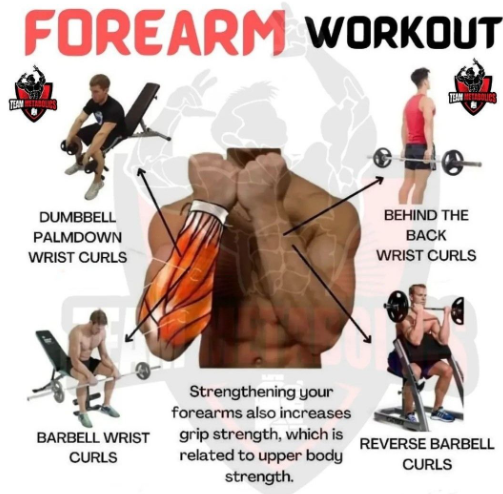BOURSESSENEGAL – Are you looking to enhance your forearm strength and improve your grip? A well-designed forearm workout can help you achieve just that. Whether you’re an athlete, a fitness enthusiast, or someone seeking better everyday functionality, focusing on your forearms can lead to impressive gains. In this guide, we’ll explore various exercises, tips, and benefits of a dedicated forearm workout.
Understanding the Importance of Forearm Strength
Before diving into specific exercises, let’s discuss why forearm strength matters. Strong forearms contribute to better grip strength, which is essential for various activities, from lifting weights to performing everyday tasks. Additionally, well-developed forearms can enhance your overall athletic performance, improve your stability, and reduce the risk of injuries.
Benefits of Strong Forearms
- Improved Grip Strength: A strong grip is crucial for lifting heavier weights and performing exercises like deadlifts and pull-ups effectively.
- Enhanced Athletic Performance: Whether you’re playing sports or engaging in fitness activities, strong forearms can help you excel.
- Reduced Injury Risk: Strong muscles and tendons in the forearms support joints and reduce strain during physical activities.
- Better Aesthetics: Well-defined forearms can enhance your overall physique, providing a balanced look to your arms.
Key Elements of an Effective Forearm Workout
To maximize your forearm workout, focus on a few key elements:
1. Variety of Exercises
Incorporating different exercises into your routine keeps your muscles challenged and engaged. Here are a few effective options:
H3: Wrist Curls
Wrist curls target the flexor muscles in your forearms. To perform this exercise:
- Sit on a bench with your forearms resting on your thighs.
- Hold a dumbbell in each hand, palms facing up.
- Curl the weights towards your body, then lower them slowly.
H3: Reverse Wrist Curls
This exercise targets the extensor muscles. Here’s how to do it:
- Similar to wrist curls, position your forearms on your thighs.
- Hold the dumbbells with palms facing down.
- Curl the weights upwards, then lower them with control.
2. Incorporating Grip Strengtheners
Adding grip-specific exercises can further enhance your forearm workout. Consider these:
H3: Farmer’s Walk
This simple yet effective exercise engages your grip and works multiple muscle groups:
- Hold a heavy dumbbell or kettlebell in each hand.
- Stand tall and walk a set distance, maintaining good posture.
H3: Plate Pinches
For this exercise, you will need two weight plates:
- Pinch two plates together with your fingers and hold them for time.
- This move challenges your grip and strengthens your forearms.
3. Focus on Form and Technique
Good form ensures you work the right muscles and reduces injury risk. Keep these tips in mind:
- Maintain a straight wrist during curls to avoid strain.
- Control the weights throughout each repetition.
- Breathe consistently, exhaling during exertion.
4. Progressive Overload
To build strength, gradually increase the weight or repetitions over time. This concept, known as progressive overload, is vital for muscle growth. Start with a manageable weight and add more as you become stronger.
Sample Forearm Workout Routine
Here’s a balanced routine to get you started on your forearm workout:
H2: Warm-Up
Begin with 5-10 minutes of light cardio or dynamic stretches to prepare your muscles.
H3: Workout Circuit
- Wrist Curls: 3 sets of 12-15 reps
- Reverse Wrist Curls: 3 sets of 12-15 reps
- Farmer’s Walk: 3 sets, walking 30-60 seconds
- Plate Pinches: 3 sets, holding for 30-60 seconds
H4: Cool Down
Finish with stretches focusing on your forearms and wrists. This helps maintain flexibility and aids recovery.
Tips for Maximizing Your Forearm Workout
To get the most out of your forearm workout, consider the following strategies:
H3: Consistency is Key
Aim to incorporate forearm training into your routine at least 1-2 times a week. Consistency leads to progress.
H3: Mind-Muscle Connection
Focus on the muscles you are working during each exercise. This connection can enhance muscle activation and growth.
H3: Nutrition Matters
Support your workouts with a balanced diet rich in protein, healthy fats, and carbohydrates. Proper nutrition fuels your body and aids recovery.
H3: Rest and Recovery
Give your forearms adequate time to recover between workouts. Muscles grow during rest, so ensure you get enough sleep and downtime.
Common Mistakes to Avoid
While pursuing your forearm workout goals, steer clear of these pitfalls:
H2: Neglecting Other Muscle Groups
Don’t focus solely on your forearms. Incorporate a balanced routine that works other muscle groups to avoid imbalances.
H3: Overtraining
Listen to your body. Overworking your forearms can lead to fatigue or injury. If you experience pain, allow time for recovery.
H3: Skipping Warm-Ups
Warm-ups are crucial for preparing your muscles and preventing injuries. Never skip this vital step.
Conclusion: Strengthening Your Forearms for Better Performance
Incorporating a dedicated forearm workout into your fitness routine can lead to remarkable improvements in grip strength, overall performance, and aesthetics. By focusing on various exercises, maintaining proper form, and committing to consistency, you’ll see significant gains.
Remember to listen to your body, prioritize nutrition, and allow for recovery. With time and effort, you’ll enjoy the benefits of strong, defined forearms that enhance both your workouts and daily activities. Now, it’s time to get started—your forearms will thank you!
REFERENCE : https://www.health.com/



